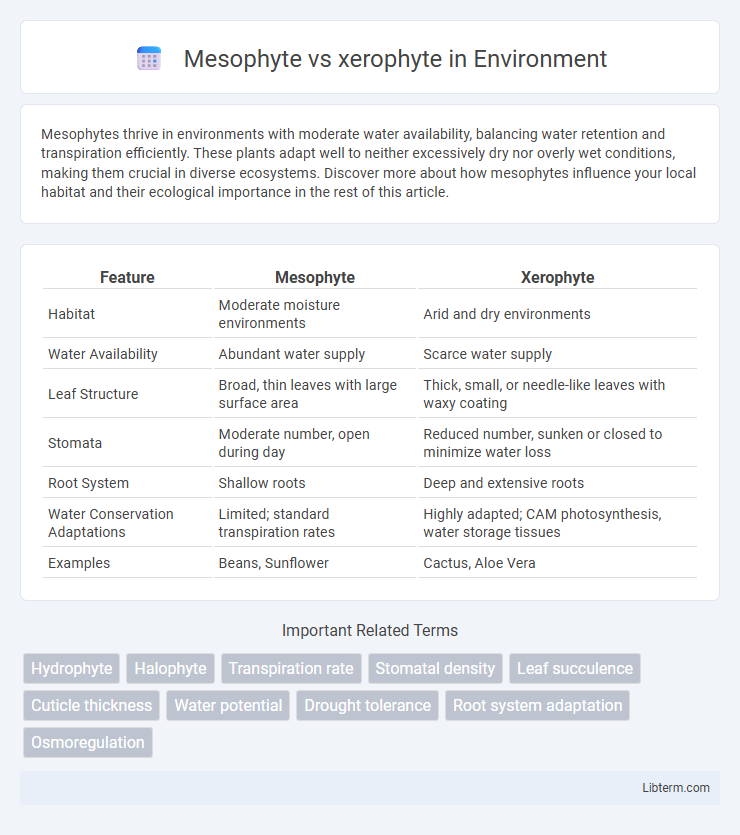Mesophytes thrive in environments with moderate water availability, balancing water retention and transpiration efficiently. These plants adapt well to neither excessively dry nor overly wet conditions, making them crucial in diverse ecosystems. Discover more about how mesophytes influence your local habitat and their ecological importance in the rest of this article.
Table of Comparison
| Feature | Mesophyte | Xerophyte |
|---|---|---|
| Habitat | Moderate moisture environments | Arid and dry environments |
| Water Availability | Abundant water supply | Scarce water supply |
| Leaf Structure | Broad, thin leaves with large surface area | Thick, small, or needle-like leaves with waxy coating |
| Stomata | Moderate number, open during day | Reduced number, sunken or closed to minimize water loss |
| Root System | Shallow roots | Deep and extensive roots |
| Water Conservation Adaptations | Limited; standard transpiration rates | Highly adapted; CAM photosynthesis, water storage tissues |
| Examples | Beans, Sunflower | Cactus, Aloe Vera |
Introduction to Mesophytes and Xerophytes
Mesophytes thrive in environments with moderate water availability, exhibiting well-developed root systems, broad leaves, and stomata adapted for balanced gas exchange and transpiration. Xerophytes are specialized plants adapted to arid conditions, featuring structural modifications such as thick cuticles, reduced leaf surfaces, sunken stomata, and extensive root networks to minimize water loss and maximize water uptake. These adaptations reflect the contrasting ecological niches of mesophytes in moist habitats versus xerophytes in dry, desert-like environments.
Defining Mesophytes: Characteristics and Habitats
Mesophytes are plants adapted to moderate environmental conditions with neither extreme dryness nor excessive moisture, thriving in habitats such as forests, grasslands, and agricultural fields. They possess well-developed root systems, broad leaves with stomata on both surfaces, and moderate cuticle thickness, optimizing water absorption and gas exchange. These characteristics enable mesophytes like oak, sunflower, and wheat to efficiently perform photosynthesis while maintaining water balance in temperate climates.
Defining Xerophytes: Characteristics and Adaptations
Xerophytes are plants adapted to survive in environments with limited water availability, such as deserts and arid regions, by possessing thick, waxy cuticles, reduced leaf surface area, and deep root systems that minimize water loss and maximize water uptake. These plants exhibit specialized adaptations like stomatal regulation, succulent tissues for water storage, and trichomes that reflect solar radiation and reduce transpiration. Mesophytes, in contrast, thrive in moderate water conditions and lack these extreme xerophytic adaptations.
Key Differences Between Mesophytes and Xerophytes
Mesophytes thrive in moderate water conditions with well-developed root systems and broad leaves for efficient photosynthesis, while xerophytes adapt to arid environments featuring thick cuticles, reduced leaf surface area, and specialized water storage tissues to minimize water loss. Mesophytes rely on ample soil moisture and exhibit stomata that open during the day, whereas xerophytes possess sunken or fewer stomata that typically open at night to conserve water. Root depth in mesophytes is generally moderate, contrasting with the extensive, deep root systems of xerophytes designed to access scarce underground water.
Structural Adaptations in Mesophytes
Mesophytes exhibit structural adaptations such as broad, thin leaves with large surface areas to maximize photosynthesis in moderate water availability environments. Stomata are typically abundant and located on the leaf surface to facilitate efficient gas exchange, supported by well-developed vascular tissues for optimal water transport. These adaptations enable mesophytes to thrive in environments with balanced water supply, contrasting with xerophytes that have features to minimize water loss.
Structural Adaptations in Xerophytes
Xerophytes exhibit specialized structural adaptations such as thick cuticles, sunken stomata, and reduced leaf surface area to minimize water loss in arid environments. Their fleshy, succulent stems and extensive root systems enhance water storage and absorption, ensuring survival during prolonged droughts. These modifications contrast with mesophytes, which possess less pronounced features suited to moderate moisture conditions.
Physiological Mechanisms: Water Conservation Strategies
Mesophytes regulate stomatal opening and close to balance water loss with CO2 intake, relying on moderate cuticle thickness and well-developed root systems for optimal water uptake under normal moisture conditions. Xerophytes exhibit specialized physiological adaptations such as reduced stomatal density, sunken stomata, and CAM (Crassulacean Acid Metabolism) photosynthesis to minimize transpiration and enhance water use efficiency in arid environments. Their robust cuticle layers and extensive root networks enable efficient water absorption and retention, allowing survival under extreme drought stress.
Ecological Roles and Environmental Impact
Mesophytes play a vital ecological role by thriving in moderate environments, supporting diverse ecosystems with balanced water availability and nutrient cycling. Xerophytes, adapted to arid conditions, contribute to soil stabilization and reduce desertification by efficiently conserving water and sustaining drought-prone habitats. Both plant types influence ecosystem resilience and biodiversity through their specialized adaptations to distinct climatic conditions.
Examples of Mesophytes and Xerophytes
Mesophytes include common plants such as oak trees, tulips, and wheat, which thrive in environments with moderate water availability. Xerophytes consist of species like cacti, aloe vera, and sagebrush, adapted to survive in arid conditions with minimal water. These examples highlight the contrasting water requirements and adaptations of mesophytes and xerophytes in different ecosystems.
Importance in Agriculture and Plant Science
Mesophytes and xerophytes play crucial roles in agriculture and plant science by adapting to varying water availability, directly influencing crop selection and land management strategies. Mesophytes thrive in moderate moisture conditions, essential for most staple crops, while xerophytes possess drought-resistant traits vital for cultivating arid and semi-arid regions. Understanding these plant types aids in developing sustainable agricultural practices and advancing research in plant physiology and environmental stress tolerance.
Mesophyte Infographic

 libterm.com
libterm.com